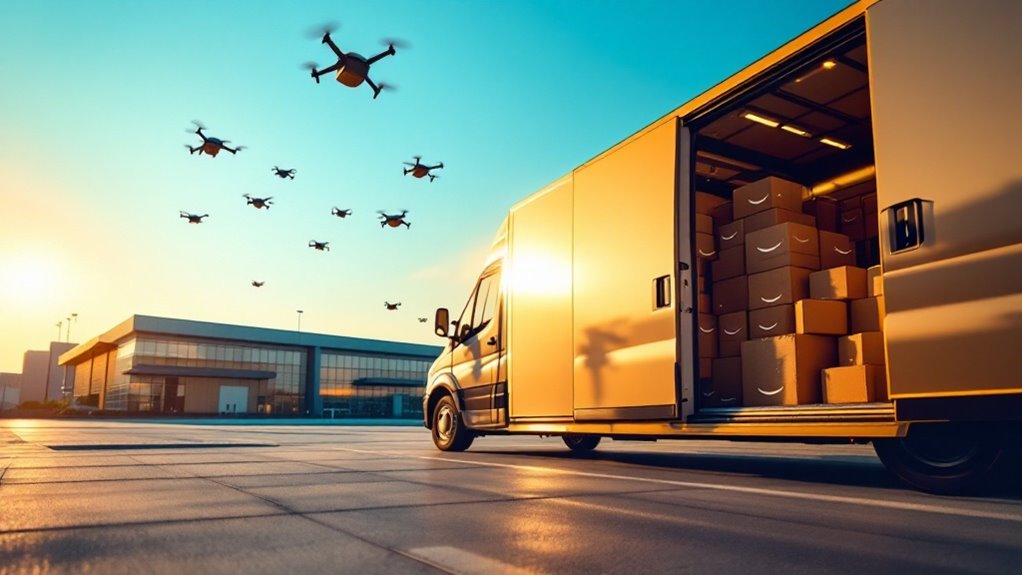Amazon dominates as the world’s most successful e-commerce company, with a market value over $1.6 trillion and 300 million active customers globally. The company’s customer-centric approach, vast product selection, and efficient fulfillment network drive its market leadership. Through continuous innovation and strategic expansion into cloud computing, grocery, and entertainment services, Amazon has evolved far beyond its online bookstore origins. This remarkable transformation reveals the blueprint for e-commerce supremacy.
Key Takeaways
- Amazon leads global e-commerce with the highest market value and serves billions of customers through its comprehensive retail platform.
- Amazon’s diverse ecosystem combines retail, cloud services, and entertainment, creating multiple revenue streams beyond traditional e-commerce.
- The company’s marketplace model enables millions of third-party sellers, offering unprecedented product variety to customers worldwide.
- Prime membership program drives customer loyalty through fast shipping and additional services, setting industry standards.
- Amazon’s data-driven approach and technological innovation consistently improve customer experience and maintain market dominance.
Amazon’s Key Success Factors and Market Dominance
Amazon’s rise to e-commerce dominance stems from several key strategic advantages developed since its founding in 1994. The company’s customer-centric approach, vast product selection, and efficient fulfillment network have created an unparalleled shopping experience.
Prime membership services, offering fast shipping and additional benefits, have fostered strong customer loyalty.
Amazon Prime’s swift delivery and value-added perks create devoted customers who stay committed to the platform’s ecosystem.
Amazon’s sophisticated data analytics and recommendation algorithms personalize the shopping experience while maximizing sales opportunities.
The company’s marketplace model allows third-party sellers to expand product offerings, while AWS cloud services generate significant revenue streams beyond retail.
Continuous innovation in areas like voice commerce (Alexa), grocery (Whole Foods), and autonomous delivery demonstrates Amazon’s commitment to market expansion.
These factors, combined with economies of scale and network effects, have established Amazon’s commanding position in global e-commerce.
The Evolution of Amazon’s E-Commerce Empire
When Jeff Bezos launched an online bookstore in 1994, few could have predicted its transformation into the world’s most valuable retail company. Initially focused on books, Amazon rapidly expanded into diverse product categories throughout the late 1990s and early 2000s.
The company revolutionized e-commerce by introducing customer reviews, one-click ordering, and personalized recommendations.
Amazon’s evolution accelerated with the launch of Amazon Prime in 2005, offering fast shipping and additional services. The company further diversified through Amazon Web Services, Kindle e-readers, and Echo smart devices.
Strategic acquisitions like Whole Foods Market in 2017 strengthened Amazon’s physical retail presence. The marketplace model, allowing third-party sellers, transformed Amazon into a global shopping platform.
Today, Amazon’s ecosystem encompasses retail, cloud computing, entertainment, and artificial intelligence, serving billions of customers worldwide.
FAQ
How Do Small E-Commerce Businesses Compete With Giants Like Amazon?
Small e-commerce businesses compete with Amazon by focusing on niche markets, offering unique products, and providing personalized customer service.
They leverage specialized expertise, build strong brand identities, and create authentic connections with customers.
Local businesses emphasize community involvement and sustainable practices.
Some differentiate through custom products, expert advice, and superior post-purchase support, while others excel in specific product categories Amazon cannot effectively serve.
What Security Measures Protect Customers During Online Shopping Transactions?
E-commerce security measures protect customers through multiple layers of defense.
SSL/TLS encryption secures data transmission between shoppers and websites. Payment gateways utilize tokenization to safeguard credit card information.
Two-factor authentication adds an extra verification step. Fraud detection systems monitor suspicious activities.
PCI DSS compliance guarantees merchants follow strict security standards. Regular security audits and updates help maintain protection against evolving cyber threats.
Which Countries Have the Highest E-Commerce Adoption Rates Globally?
China leads global e-commerce adoption, followed closely by South Korea and the United Kingdom.
These nations showcase high digital literacy, robust internet infrastructure, and widespread mobile payment adoption.
Indonesia and India demonstrate rapid growth in e-commerce penetration, driven by increasing smartphone usage and digital transformation.
Northern European countries like Denmark and Norway consistently rank high due to their advanced digital economies and tech-savvy populations.
How Does Seasonal Timing Affect E-Commerce Sales and Consumer Behavior?
Seasonal timing markedly influences e-commerce sales patterns. Major shopping events like Black Friday, Cyber Monday, and holiday seasons drive peak consumer activity.
Summer months typically see lower sales, except for specific categories like outdoor gear. Weather conditions affect purchasing decisions, with rainy or cold periods increasing online shopping.
Retailers adjust inventory, marketing strategies, and pricing based on these predictable seasonal fluctuations in consumer behavior.
What Percentage of E-Commerce Purchases Are Made Through Mobile Devices?
“Time waits for no one,” and neither does mobile commerce.
Recent statistics indicate that mobile devices account for approximately 70% of all e-commerce purchases globally. In developed markets like the United States, mobile shopping represents about 73% of total e-commerce transactions, while some Asian markets see even higher rates at 85%.
This trend continues to grow as smartphones become increasingly integral to everyday shopping habits.
Conclusion
As Amazon’s influence continues to reshape global commerce, its path to dominance reveals more than just retail success. From humble beginnings as an online bookstore to becoming the world’s most valuable e-commerce platform, Amazon’s story exemplifies how innovation, customer obsession, and strategic expansion can transform an industry. Yet the question remains: what unprecedented heights will this digital giant reach next?







